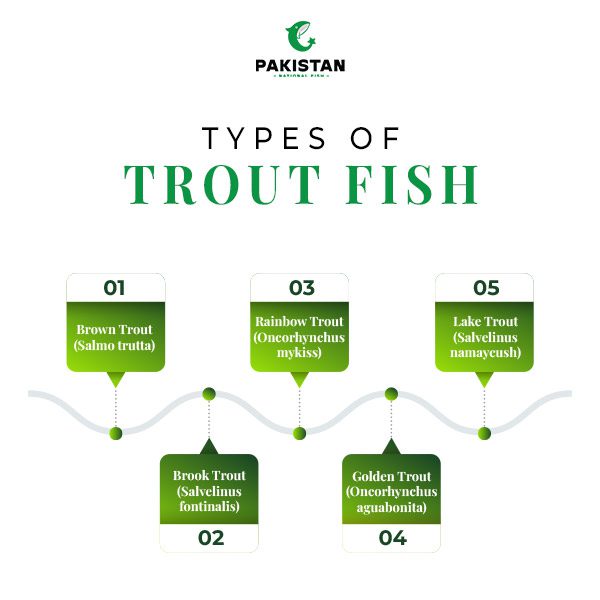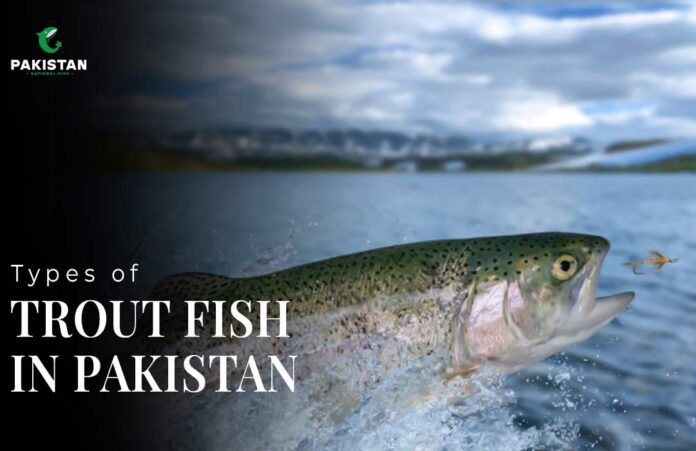Different types of trout find habitat in the pure, cold, and transparent rivers in northern areas of Pakistan, especially in Khyber Pakhtunkhwa and Gilgit-Baltistan. Fishermen admire these areas because they offer the ideal habitat for trout fish and calm environments.
In addition to being valued for their taste and physical characteristics, trout fish are also highly demanded for sport fishing. As trout fishing attracts tourists and promotes sustainable fishing in Pakistan, it has evolved to be a key component of the local economy and culture.
What Is Trout Fish?
Trout is a highly valued game and food fish from the Salmonidae family (order Salmoniformes) that are primarily found in freshwater, but some species do travel to the ocean in between breeding seasons. Salmon fish and trout are closely related to each other. In order to eventually be released into livable bodies of water, these significant sport fish are frequently grown in hatcheries.
Top 5 Types Of Trout Fish In Pakistan
Here are the top five types of trout fish found in Pakistan:

1. Brown Trout (salmo Trutta)
Brown trout are coloured from brown to yellow-brown, and during the spawning season, their colour is enhanced with orange tones. Their bodies are marked with red spots with white margins and black patches. Their anal, pelvic, and pectoral fins are orange to yellow in colour, while their adipose fin has a red border with red dots.
The gill plate of these types of fish may turn blue, and the tail often has few or no dots. Brown trout have a slightly twisted caudal fin and nine to fourteen anal fin rays.
2. Brook Trout (salvelinus Fontinalis)
The sides of brook trout are covered with blue-hued yellow and red dots, while their dark green back is covered with extended patches. During the spawning season, the side appearance changes from green to a lower quarter that is either yellow or red in colour. Their anal, pelvic, and pectoral fins are red with a noticeable white margin, and their belly is silvery white.
Brook trout have nine to thirteen anal fin rays, their caudal fin is somewhat divided, and their tail consists of wide spots.
3. Rainbow Trout (oncorhynchus Mykiss)
Rainbow Trout have an olive green back that transitions to a silvery green side appearance. The caudal fin is spotted, and there are black patches on the flanks, back, and top fins, usually without edges.
The Gill plate and sides of Rainbow Trout are coloured with a reddish-pink hue. They have 10–12 anal fin rays, and their belly is silvery white. The caudal fin of rainbow trout is slightly curved.
4. Lake Trout (salvelinus Namaycush)
Lake trout have a body colour that ranges from dark brown to silvery green, with cream-coloured patches or spots on the body and fins. The pelvic, anal, and pectoral fins have a faded white margin and are a lighter brown colour. They have eight to twelve anal fin rays and a deeply twisted caudal fin.
5. Golden Trout (oncorhynchus Aguabonita)
Golden trout are identified by their golden yellow body colour and somewhat greenback. Their lateral and caudal fins, as well as the upper and rear sections of their body, are covered with black dots.
Golden trout has a reddish-pink stripe running down the lateral line and the gill plate highlights about ten parr markings that are seen along the lateral line. With black and white tips, the anal, pelvic, and pectoral fins are orange in colour. The average golden trout has eleven or twelve anal fin rays.
5. Golden Trout (oncorhynchus Aguabonita)
The optimum time to fish for trout varies according to the season, time of day, and temperature. Just like freshwater fishing, trout fishing is available all year round. However, to improve your chances of success, consider the following tips:
- The general opinion is that late spring is the ideal time to capture trout, particularly if you want bigger fish.
- The warmer it gets, the more anglers are fishing, the denser the grass and brush around their habitats, and the lower the water levels become. Although some consider it a myth, trout could be better educated about avoiding lures and bait later in the season.
- Because trout are cold-blooded and their body temperatures reflect the water they swim in, if the air temperature is uncomfortable for you (below freezing or unbearably hot), fishing will also be uncomfortable for them.
Conclusion
Trout fishing is highly valued in the northern regions of Pakistan, specifically in Khyber Pakhtunkhwa and Gilgit-Baltistan, due to its favourable conditions and substantial contribution to the local economy and culture. In these areas, the most common trout species are Brown Trout (brown to yellow-brown colouration with red spots); Brook Trout (blue-hued yellow and red dots and dark green back); Rainbow Trout (olive green back and reddish-pink gill plates); Lake Trout (dark brown to the silvery green body with cream-coloured patches); and Golden Trout (golden yellow body and black dots). In addition to increasing the region’s biodiversity, these species draw tourists and encourage ethical fishing methods.


